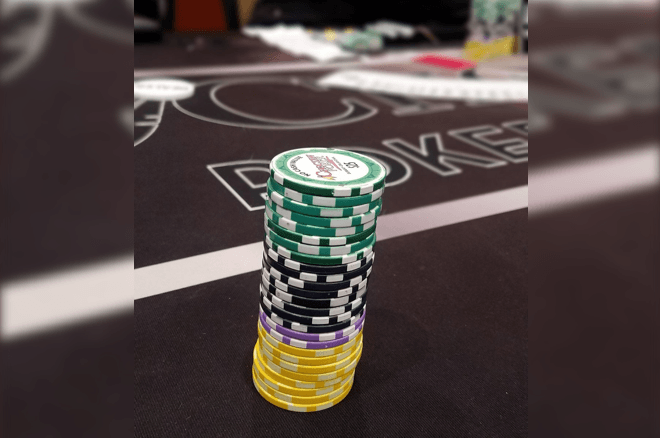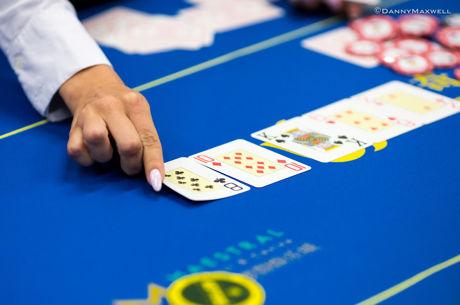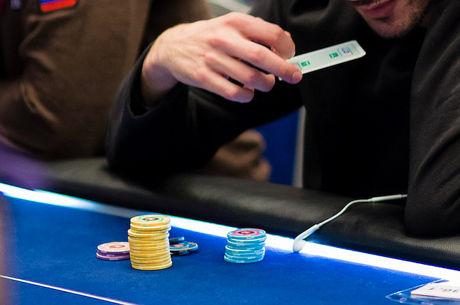Hand Review: A River Bluff Folds Out Two Opponents

Covering live poker tournaments for a living affords me the opportunity to see countless thousands of hands played out, many of which offer interesting and potentially valuable insights into how players �� both amateurs and professionals �� play the game. In this ongoing series, I'll highlight hands I've seen at the tournaments I've covered and see if we can glean anything useful from them.
The Scene
I still have a few more hands I want to go over from the fantastic PokerStars Championship Prague final table, but we're going to take a quick detour for a little while because I recently traveled to the lovely location of Durant, Oklahoma, for the World Series of Poker Circuit Choctaw. I've played a few interesting hands and I think it works best for me to go over them while they're still fresh in my mind.
This first hand I want to review comes from the $580 buy-in ring event on Day 1, at the 100/300/600 level with me having plenty of chips and covering two opponents who had around 10,000 apiece.
Both players had been relatively solid and reasonably aggressive, especially compared to the typical Circuit fields in a place like this. Prior to the following hand, the one on my left had slow played a straight on the river and failed to get in a check-raise when it checked around three ways in an earlier hand.
The Action
Action folded to the player in the hijack, who made it 1,200 to go. I called in the small blind with Kx10x and the big blind came along as well.
The three of us saw a flop of 8?Q?10?, which checked around. The turn brought a low brick that I can't for the life of me recall, and I bet 2,200. The big blind called, as did the preflop opener.
On the 8? river, I tanked awhile and checked. The big blind moved all in for around 6,500 and the opener thought about 30 seconds and mucked. I thought for a little while and did the same. The big blind showed 9?7? for a whiffed straight draw as he collected the pot.
Concept and Analysis
While certainly not the biggest pot in the world, this was a fun hand because it involved ranging a couple of opponents and strongly considering changing strategies from a value bet on one street to an all-in bluff on the very next.
Preflop, Kx10x is probably one of the weakest hands I'd call with, but I think it plays fine postflop since it makes solid pairs and the reverse implied odds are pretty minimal with the only other players in the pot sitting on shorter stacks.
When I flopped second pair and a good kicker, I considered leading out as I would with a number of hands. The reason I like leading these flops with �� hopefully �� a balanced range is that I find they often get checked around, with the preflop raiser taking free cards with hands that have reasonable equity and most likely not bluffing very often. So it's good to lead your strong hands, too, and you can balance it with some weaker stuff like low flush draws.
In this case, I check and it does indeed check through to a brick turn. At this point, I think it's best to just bet to protect my hand and get value from worse tens and stuff like 9x8x. I was a little worried about a hand like that shoving on me, but we'd cross that bridge if we came to it, and for the moment it appeared my hand was likely best.
However, I was surprised after my turn bet to get two calls, and a very interesting river came down when the 8? paired the board.
It didn't seem likely the preflop opener had a very strong hand since he declined a chance to continuation bet on a fairly wet board, but what about the big blind? He had already shown a willingness to slow play a big hand in a similar spot. He could also have a weak queen, something like Qx7x-suited, since he peeled for a min-raise getting huge odds out of the big blind.
I considered the merits of turning my hand into a bluff and moving all in. I thought there was a decent chance I could fold out a weak queen from the big blind. I could definitely have trip eights or a straight in this spot myself, having called for a good price in the small blind.
In the end, I decided to check and pray I could get to showdown. But the big blind shoved and the opener folded, leaving me with a decision.
I was suspicious, as I thought he might shove the turn with a big hand, considering the draws out there and the fact that the pot was multi-way. However, figuring there was a chance he had an eight and there were better spots to be found, I folded.
From the big blind's perspective, though, consider the spot he's in. He's likely facing two capped ranges unless I got really tricky on the river and checked a monster. We've already gone over why the opener shouldn't usually be nutted here. A scary card hit that he can represent and his hand has no value to showdown. It's the perfect spot to bluff-shove it in.
If you're going to peel with hands like 9x7x, it's essential to look for the occasional spot to steal a pot with a bluff. Your ranges are wide, meaning you can rep more hands than your opponents in most cases. It's hard to show down winners with such hands, so to turn a profit, you need savvy postflop play. The big blind found a great spot to bluff here and it paid off when he pulled the trigger.









